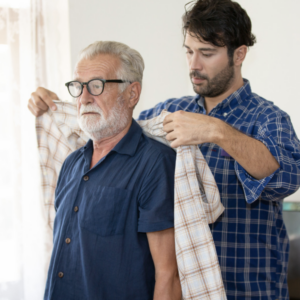Skill Set: Can You Still Handle The Practical Activities Of Daily Living?

Skill Set: Can You Still Handle The Practical Activities Of Daily Living?
March 30, 2022
Intuitively, you likely know what the essential skills are for living independently and on your own in the community: You need to be able to walk (or otherwise get around your environment), eat, and toilet yourself. You also need to be able to obtain and prepare food, keep yourself and your environment clean, and handle whatever medications you take and finances you have to support yourself. These skills are known as “Activities of Daily Living (ADLs) ” and “Instrumental Activities of Daily Living (IADLs).” You may have encountered an older loved one or acquaintance who seems to be losing some of these skills. Maybe they don’t answer their phone anymore; maybe they appear more disheveled or unkempt than usual; maybe the refrigerator is empty or dishes have piled up too high in the sink. Are these fixable red flags or fatal factors suggesting the need for help or even placement in a long-term care facility? The answer depends- on what skills are lost and what supports are found.
ADLs and IADLs are the essential, routine tasks that independent people in the community can accomplish without assistance. While it is possible for someone to live alone in the community without expertly accomplishing all of these skills, they are important indicators of whether an older adult is living in an unsafe condition or suffering from a condition or disease that is affecting their ability to carry on. There are many reasons these skills may decline or even disappear: An older adult may be suffering a neurological, circulatory, sensory, or musculoskeletal condition; there may be a cognitive decline or a medication side effect clouding judgment or decision-making; social isolation could play a role or there may be general decline following a hospitalization. “Many hospitalized older people are discharged with ADL function that is worse than their baseline function.”. In fact, assessment of ADL and IADL functioning is one of the essential aspects of hospital discharge planning- the goal is to ensure that an older adult can function alone in the community or if not, includes an evaluation of what kind of support needs to be in place before the patient can be safely discharged.
Assessment of ADLs and IADLs is also a trigger to determine an older person’s eligibility for some community-based financial assistance or service programs. For example, Medicare Advantage Plans or PACE programs will examine an applicant’s ADLs and IADLs to measure a person’s level of functioning and need for support. Oftentimes, an inability to perform 2-3 activities (like getting oneself to the toilet or ambulating around an apartment) will be the criteria used to determine participation in a program. Such evaluations may also trigger the initiation of payments for a long-term care insurance policy. Usually, either a physician or occupational therapist will conduct an ADL assessment.
If you’re trying to determine a loved one’s “ADL functionality” there are lots of resources online to help. Better Health While Aging has a valuable checklist to take you through the sorts of questions and activities you should review. PBS has also published a checklist that can help with an ADL evaluation. What’s important to remember is that it’s usually not all or nothing. Most older adults living in the community may need help with some tasks but may be able to undertake others without help. So, for example, someone may need grab bars or a shower seat and a hand-held shower head to take a shower but may be able to wash themselves once seated or helped into the shower. The goal is to provide support without infantilizing someone- but you also don’t want to leave them stranded.
It can be a tricky balance to strike. Unmet ADL needs can lead to such declining health factors as malnutrition, poor personal hygiene, urinary tract infections, or even serious falls. Yet many adults may either be in denial of their deficits or resist help that could keep them safe and in the community. Alternatively, many who clearly qualify and desire help may live in communities where such help is limited or non-existent. While everyone has the right to live their lives as they wish, at the same time, as a society we need to be aware of older adults whose decline or deterioration is a result of impaired judgment or illness, not a desired lifestyle choice. Assessment of ADLs and IADLs then becomes an essential factor in determining what care is needed and where it is best provided (and who will pay for it). These are often not easy determinations- but of course, nothing having to do with long-term care is ever easy!







